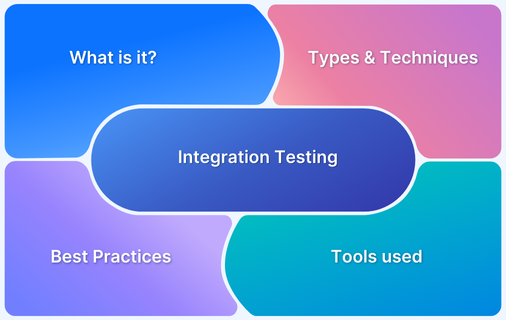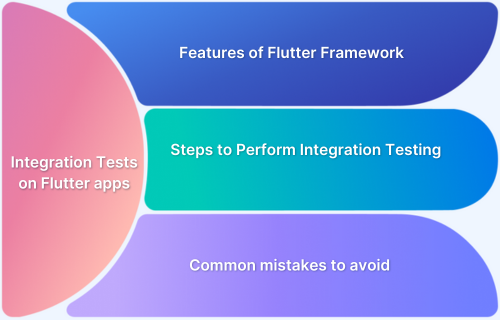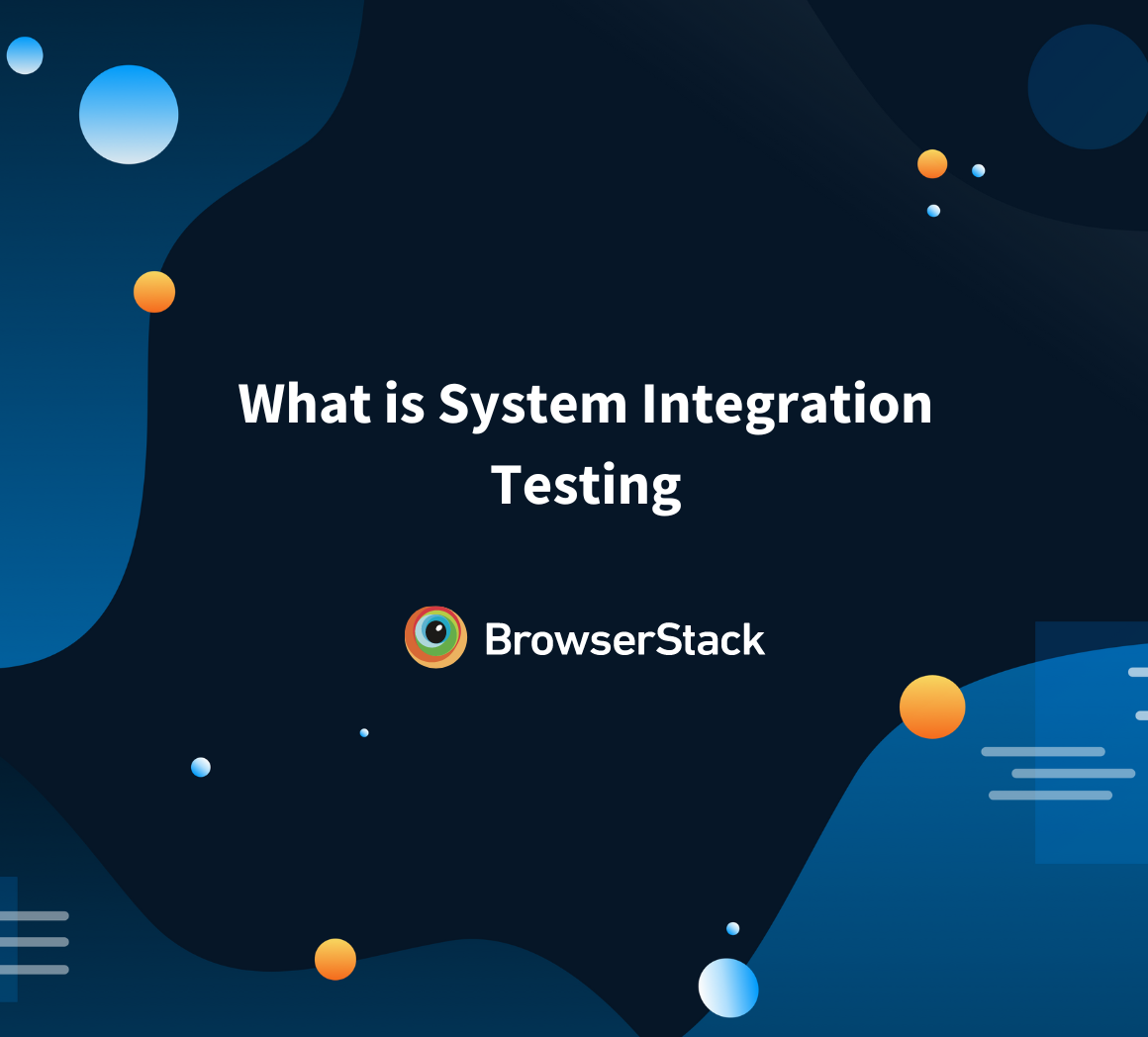Are integration issues slowing down your software releases? They remain one of the top causes of defects in production. Automated integration testing can help by validating how modules interact early, preventing costly issues before deployment.
In fact, 72% of successful businesses use test automation in their deployment processes, including integration testing, saving time and enhancing release quality.
Overview
Why Automate Integration Testing?
- Speed and efficiency
- Early defect detection
- Consistency
- Scalability
- Continuous feedback
This article delves into automated integration testing, its significance, challenges, best practices and more.
What is Automated Integration Testing?
Integration testing checks whether multiple software modules work together as intended. Unlike unit testing, which focuses on individual components, integration testing emphasizes data flow and communication between modules.
Automated integration testing uses test scripts, frameworks, and environments to repeatedly validate interactions without manual intervention. These tests ensure:
- APIs exchange data correctly.
- Microservices communicate as expected.
- External systems (like payment gateways or authentication providers) integrate smoothly.
For instance, in an e-commerce application, automated integration tests might verify that the checkout system communicates correctly with the inventory service and payment provider.
Why Automate Integration Testing?
Manual integration testing can quickly become repetitive and error-prone, especially in large systems. Automation delivers several advantages:
- Speed and efficiency: Automated suites can validate hundreds of integration points in minutes, compared to hours of manual testing.
- Early defect detection: Issues are caught as soon as new modules are integrated, reducing the cost of bug fixes later.
- Consistency: Automated scripts ensure every run executes identically, eliminating tester bias.
- Scalability: As projects grow, automated tests handle the increased volume of integration points.
- Continuous feedback: When tied to CI/CD pipelines, automated tests provide instant visibility into integration health.
Read More: What is System Integration Testing
Types of Integration Testing
There are several approaches to integration testing, and automation can be applied to each depending on system complexity.
Big Bang Integration Testing
- All modules are combined and tested at once.
- Use case: Works best for small projects with fewer components.
- Limitations: Debugging failures becomes difficult because the root cause is not immediately clear.
Top-Down Integration Testing
- Testing begins from the highest-level modules and moves downward. Stubs may be used to simulate lower modules.
- Use case: Ideal for systems where high-level workflows are critical.
- Limitations: Lower modules may not receive thorough early testing.
Bottom-Up Integration Testing
- Testing starts with lower-level modules, gradually progressing to higher modules. Drivers may be needed to mimic upper modules.
- Use case: Effective when low-level utilities form the backbone of the system.
- Limitations: End-to-end workflows aren’t validated until later.
Sandwich (Hybrid) Integration Testing
- Combines top-down and bottom-up, testing both simultaneously before merging.
- Use case: Suitable for large systems with multiple hierarchies.
- Limitations: Requires careful planning and additional resources.
When to Implement Automated Integration Testing?
Automated integration testing should be introduced at specific stages for maximum benefit:
- Post-unit testing: Once modules pass unit tests, integration tests confirm inter-module communication.
- Before system testing: Ensures integration issues don’t cascade into full system tests.
- During CI/CD workflows: Every new build should trigger automated integration tests for fast feedback.
- In microservices architectures: Whenever APIs or services are updated, integration tests prevent contract-breaking changes.
Best Practices for Automated Integration Testing
For effective implementation, teams should follow structured practices:
- Define clear interfaces: Document module interactions thoroughly to avoid ambiguity.
- Use mocks and stubs wisely: Simulate unavailable modules without compromising test accuracy.
- Focus on critical paths: Prioritize integration points that impact business workflows.
- Maintain test data consistency: Use standardized test data to avoid inconsistent results.
- Monitor test execution time: Keep integration suites optimized to avoid slowing down pipelines.
- Ensure environment parity: Tests should run in environments that mirror production as closely as possible.
Tools and Frameworks for Automation
Choosing the right tools is critical for successful automated integration testing. Below are some widely used frameworks and platforms, explained with their overview, key features, advantages, and limitations.
BrowserStack Automate
BrowserStack Automate is a cloud-based testing platform that allows automated integration and functional tests to run on thousands of real browsers and devices. It eliminates the need to maintain in-house device labs and ensures applications are validated under real-world conditions.
Key features:
- Supports Selenium, Cypress, Playwright, and other popular frameworks.
- Provides access to 3500+ real browsers and devices.
- Seamless integration with CI/CD tools like Jenkins, GitHub Actions, and Azure DevOps.
- Detailed dashboards with logs, video recordings, and screenshots for debugging.
Pros:
- Real device testing ensures accuracy and reliability.
- Scalable infrastructure for parallel test execution.
- Quick setup with no device maintenance overhead.
- Strong developer ecosystem and documentation.
Cons:
- Internet connectivity is required for execution.
- High test concurrency may require upgraded plans.
JUnit
JUnit is a unit testing framework for Java that also supports integration testing when combined with test suites and external libraries. It is widely adopted in Java-based enterprise applications.
Key features:
- Simple annotations for defining test cases.
- Supports parameterized and grouped test execution.
- Easily integrates with build systems like Maven and Gradle.
Pros:
- Lightweight and easy to set up.
- Large community support and extensive resources.
- Strong integration with CI/CD pipelines.
Cons:
- Primarily designed for unit tests; integration testing requires additional setup.
- Limited out-of-the-box support for complex integration scenarios.
TestNG
TestNG is a testing framework inspired by JUnit but designed with more flexibility for integration and functional testing. It is widely used in enterprise-grade automation projects.
Key features:
- Supports test grouping, prioritization, and parameterization.
- Generates rich HTML test reports.
- Built-in support for parallel execution.
Pros:
- More powerful than JUnit for complex test management.
- Great for large-scale projects needing detailed test organization.
- Strong ecosystem and CI/CD compatibility.
Cons:
- Steeper learning curve compared to JUnit.
- Requires additional configuration for beginners.
Postman (with Newman)
Postman is a leading tool for API integration testing. With Newman, its command-line companion, teams can run automated API integration tests in CI/CD pipelines.
Key features:
- GUI for designing and executing API requests.
- JavaScript scripting for validation and automation.
- Newman CLI for test execution in pipelines.
Pros:
- Easy to use for both developers and testers.
- Great for validating microservices and API-based architectures.
- Supports environment variables for testing across environments.
Cons:
- Limited functionality beyond API testing.
- Complex workflows may require significant scripting.
Pytest
Pytest is a Python-based framework that supports unit and integration testing. Its flexible fixture system makes it effective for managing dependencies in complex integration setups.
Key features:
- Fixture-based dependency management.
- Rich plugin ecosystem for extending functionality.
- Supports parallel execution with plugins like pytest-xdist.
Pros:
- Highly extensible and Pythonic.
- Great for microservices and API integration testing.
- Strong community and plugin availability.
Cons:
- Primarily for Python projects.
- Test discovery and configuration may confuse beginners.
Read More: Understanding Pytest BDD
Selenium
Selenium is an open-source automation framework for web applications. While primarily focused on UI testing, it can also validate front-end and back-end integration.
Key features:
- Cross-browser automation on Chrome, Firefox, Safari, Edge, etc.
- Supports multiple programming languages (Java, Python, C#, etc.).
- Integrates with cloud platforms like BrowserStack for real device execution.
Pros:
- Industry-standard tool for browser-based testing.
- Flexible and language-agnostic.
- Large community support.
Cons:
- Limited native reporting; needs third-party tools.
- Maintenance overhead for locators and scripts.
- Flakiness issues if not implemented with care.
Challenges in Automated Integration Testing
Despite its advantages, teams often face hurdles:
- Complex environment setup: Multiple dependent modules may require elaborate test environments.
- Data dependency issues: Ensuring consistent data across modules is difficult.
- Maintenance overhead: Integration test scripts need frequent updates when modules evolve.
- Flaky tests: Network delays or asynchronous operations may cause false positives/negatives.
- Cost of infrastructure: Running integration tests at scale requires robust environments.
Integrating with CI/CD Pipelines
Integration testing achieves its true potential when embedded in CI/CD pipelines.
- Automated triggers: Every code commit can trigger integration tests.
- Parallel execution: Running tests simultaneously reduces bottlenecks.
- Rollback strategies: If integration tests fail, pipelines can halt deployments automatically.
- Reporting and feedback loops: Developers receive instant alerts to fix integration issues quickly.
Integrating automated integration testing with your CI/CD pipeline is essential for faster, more reliable deployments. Reaching out to experts will help ensure the integration is set up correctly, test execution is optimized, and catch issues early and maintain high-quality releases without manual intervention.
Get Expert QA Guidance Today
Schedule a call with BrowserStack QA specialists to discuss your testing challenges, automation strategies, and tool integrations. Gain actionable insights tailored to your projects and ensure faster, more reliable software delivery.
Why run Automated Integration Testing on Real Devices?
Many integration problems only surface under real-world conditions, especially for mobile and cross-platform applications.
- Device diversity: Different OS versions and device models may reveal unique integration issues.
- Network variations: Real bandwidth, latency, and packet loss conditions affect API and service integrations.
- Browser behavior: Web modules may behave inconsistently across browsers.
BrowserStack Automate allows teams to execute automated integration tests on a wide range of real devices and browsers in the cloud. This eliminates the need for costly in-house device labs while ensuring reliable results across environments.
Conclusion
Automated integration testing ensures that modules work seamlessly together, reducing system failures and deployment risks. While challenges like environment setup and maintenance exist, the right tools and practices can streamline the process.
Running integration tests on real devices through BrowserStack Automate provides the reliability and accuracy needed for today’s complex applications. By embedding these tests into CI/CD pipelines, organizations can achieve faster releases without compromising quality.






